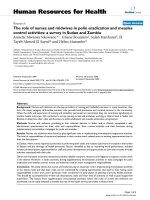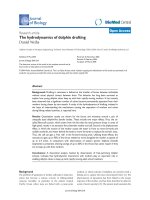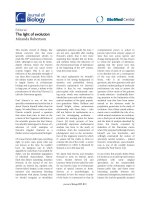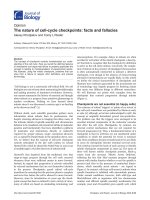Báo cáo sinh học: " The pattern of genetic and environmental variation in relation to ageing in laying hens" ppt
Bạn đang xem bản rút gọn của tài liệu. Xem và tải ngay bản đầy đủ của tài liệu tại đây (509.2 KB, 11 trang )
Original
article
The
pattern
of
genetic
and
environmental
variation
in
relation
to
ageing
in
laying
hens
G
Engström,
LE
Liljedahl
M
Wilhelmson,
K
Johansson
Swedish
University
of
Agricultural
Sciences,
Department
of
Animal
Breeding
and
Genetics, S -
750
07
Uppsala,
Sweden
(Received
12
June
1991;
accepted
31
March
1992)
Summary -
Data
from
a
selection
experiment
with
laying
hens
were
used
to
study
the
structure
of
genetic
correlations,
as
well
as
additive
genetic
and
environmental
variation
over
a
period
of
26-60
weeks
of
age.
Genetic
correlations
were
positive
between
all
age
periods
for
the
2
traits
investigated,
egg
number
and
egg
weight.
Thus,
the
results
do
not
support
the
pleiotropy
theory
of
ageing
which
predicts
negative
genetic
correlations
between
early
and
late
fitness.
For
egg
weight
no
trend
with
age
was
found
for
the
2
components
of
variance
investigated.
For
egg
number
there
was
an
increase
in
additive
genetic
variation
as
well
as
in
environmental
variation
with
age.
The
results
support
the
mutation
accumulation
theory
of
ageing
and
other
theories
which
postulate
an
increasing
genetic
variation
with
age.
genetic
variation
/
environmental
variation
/
genetic
correlation
/
age
changes
Résumé -
Évolution
avec
l’âge
de
la
variance
génétique
et
de
la
variance
de
milieu
chez
des
poules
pondeuses.
Les
résultats
d’une
expérience
de
sélection
de
poules
pondeuses
ont
été
utilisés
pour
étudier,
entre
26
et
60
semaines
d’âge,
l’évolution
des
corrélations
génétiques
et
des
variances
génétiques
et
de
milieu.
Les
corrélations
génétiques
entre
différents
âges
étaient
positives
pour
les
2
caractères
étudiés,
nombre
d’oeufs
et
poids
des
oeufs.
Ces
résultats
ne
confortent
pas
la
théorie
de
pléiotropie
du
vieillissement
qui
prédit
des
corrélations
génétiques
négatives
entre
différents
âges.
Pour
le
poids
des
oeufs,
aucune
variation
systématique
avec
l’âge
des
deux
variances
n’a
été
relevée.
Pour
le
nombre
d’oeufs
par
contre,
les
2 variances
augmentaient.
Ces
résultats
renforcent
les
théories
(notamment
celle
de
l’accumulation
des
mutations
avec
l’âge)
qui prédisent
une
augmentation
avec
l’âge
de
la
variance
génétique.
variance
génétique
/
variance
due
au
milieu
/
corrélation
génétique
/
changements
dus
à
l’âge
INTRODUCTION
Increased
knowledge
about
reproductive
fitness
and
the
fundamental
causes
of
ageing
is
essential
in
order
to
be
able
to
increase
lifespan
and
lifetime
production
capacity
in
our
domestic
animals.
The
pleiotropy
theory
of
ageing
(Williams,
1957)
assumes
that
ageing
is
caused
by
pleiotropic
or
closely
linked
genes
with
beneficial
effects
at
an
early
age,
but
unfavourable
effects
at
a
late
age.
This
theory
predicts
negative
genetic
correlations
between
early
and
late
fitness.
Negative
genetic
correlations
have
actually
been
found
in
several
investigations.
Early
fecundity
decreased
and
late
fecundity
increased
in
response
to
selection
for
late
fitness
in
selection
experiments
with
Drosophila
!nelanogaster
by
Rose
and
Charlesworth
(1981b)
and
Luckinbill
et
al (1984).
Where
genetic
correlations
have
been
calculated
from
pedigreed
populations
of
Drosophila
melanogaster,
some
estimates
between
early
and
late
fecundity
have
been
found
to
be
negative
(Rose
and
Charlesworth,
1981a;
Tucic
et
al,
1988)
while
others
have
reported
positive
correlations
(Giesel,
1986;
Engstr6m
et
al,
1989).
When
investigating
part
record
production
in
laying
hens,
Clayton
and
Robertson
(1966)
found
positive
genetic
correlations
between
early
and
late
production,
while
Flock
(1977)
mainly
found
positive
genetic
correlations
but
negative
correlations
were
also
found.
Fairfull
and
Gowe
(1990)
also
found
mainly
positive
genetic
correlations
between
part
record
production
in
their
literature
review.
The
mutation
accumulation
theory
of
ageing
(Medawar,
1952)
suggests
that
age-
ing
is
caused
by
late-acting
mutations
accumulating.
These
deleterious
mutations
accumulate
due to
their
small
effects
on
early
fitness.
The
mutation
accumulation
theory
predicts
increasing
additive
genetic
variation
with
age.
Rose
and
Charlesworth
(1981a)
did
not
find
any
trend
in
additive
genetic
vari-
ation
with
age
when
studying
a
population
of
Drosophila
melanogaster.
However,
Liljedahl
et
al
(1984)
dealing
with
2
populations
of
laying
hens
reported
a
positive
trend
in
genetic
variation
with
age
for
various
egg
production
traits.
An
increase
in
additive
genetic
variation
with
age
for
fecundity
traits
in
Drosophila
melanogaster
was
found
by
Tucic
et
al
(1988)
and
by
Engstrbm
et
al
(1989).
Evidence
for
the
2
evolutionary
theories
described
above
both
playing
a
role
in
the
ageing
process
was
found
by
Service
et
al
(1988).
Reverse
selection
was
applied
to
lines
previously
selected
for
late
fitness.
Some
of
the
fitness
traits
studied
responded
in
accordance
with
the
pleiotropy
theory,
while
other
traits
showed
no
response,
which
supports
the
mutation
accumulation
theory.
In
addition
to
the
2
evolutionary
theories
dealt
with
previously
there
are
several
other
theories,
one
of
which
suggests
that
more
and
more
inactive
genes
are
turned
on
as
needed
during
the
course
of
ageing
to
counteract
the
negative
effect
of
increased
sensitivity
to
environmental
stress
(Liljedahl
et
al,
1984).
Another
theory
postulates
that
genetic
damage
accumulates
with
age,
causing
different
effects
on
the
organism,
the
effect
reflecting
the
individual
capacity
of
DNA
repair
(Hart
and
Setlow,
1974).
These
2
theories
also
predict
increasing
additive
genetic
variation
with
age.
The
present
study
investigates
the
relationship
between
additive
genetic
as
well
as
environmental
variation
and
genetic
correlations
for
egg
production
traits
at
different
ages
in
laying
hens.
MATERIAL
AND
METHODS
The
2
selected
lines
used
in
this
investigation
originated
from
a
base
population
of
laying
hens
which
was
formed
by
mating
7
commercial
laying
stocks
in
a
diallel
system.
The
resulting
population
was
randomly
mated
for
3
generations
before
the
formation
of
the
different
selected
lines
(Liljedahl
et
al,
1979).
Two
selection
lines
were
used
in
this
experiment,
one
line
selected
for
number
of
eggs
(En)
and
the
other
line
for
egg
weight
(Ew).
The
selection
was
based
on
the
performance
during
20-42
weeks
of
age
in
both
lines.
The
average
rate
of
inbreeding
was
approximately
0.73%
per
generation.
The
environmental
conditions
were
as
usually
recommended
for
commercial
egg
production
except
that
the
hens
were
fed
a
suboptimal
diet
(10.5
MJ/kg
and
13%
crude
protein)
and
housed
in
single-hen
cages.
A
more
detailed
description
of
the
2
lines
and
the
environmental
conditions
can
be found
in
Liljedahl
and
Weyde
(1980).
The
traits
considered
in
this
study
were
number
of
eggs
(EN,-EN
5)
and
egg
weight
(EW
1
-EW
s)
during
5
age
periods
(26-32;
33-39;
40-46;
47-53
and
54-60
weeks
of
age).
Every
second
egg
during
the
laying
period
was
weighed.
Only
hens
surviving
the
entire
experimental
period
(90.6%)
are
included
in
the
data
set.
The
results
may
possibly
be
slightly
biased
if
hens
who
died
early
had
a
worse
or
better
performance
than
the
ones
included
in
the
analysis.
In
a
similar
study
with
Drosophila
melanogaster
the
excluded
group
showed
a
very
similar
performance
as
compared
with
those
included
in
the
analysis
(Engstr6m
et
al,
1989).
Individual
records
from
an
average
of
419.8
hens
per
generation
and
line,
bred
from
an
average
of
18.6
sires
and
112.8
dams,
were
used
for
estimating
genetic
parameters
and
variance
components
within
each
line
and
generation.
Data
from
4
generations
were
used.
Number
of
eggs
laid
decreased
and
egg
weight,
increased
with
age.
To
take
into
account
the
dependence
between
the
mean
and
the
variance,
data
was
transformed
to
a
logarithmic
scale.
The
method
used
to
calculate
variance
and
covariance
components
for
the
10
different
traits
was
Multivariate
Restricted
Maximum
Likelihood
using
an
individual
animal
model
(Meyer,
1986).
The
only
factor
in
the
model
was
the
random
effect
of
hen.
The
hens
were
kept
under
well
controlled
conditions
which
means
that
no
environmental
effects,
such
as
differences
between
locations
in
the
hen
house,
could
be
detected.
The
covariance
structure
among
individuals
was
taken
into
account
by
a
complete
relationship
matrix.
The
2
variance
components
were
estimated
using
an
EM
algorithm.
As
input
to
the
multivariate
analyses,
variance
component
estimates
from
univariate
analyses
were
used.
The
iterations
were
continued
until
the
difference
between
2
successive
rounds
was
less
than
0.01%
for
the
2
variance
components
estimated.
The
variance
component
between
hens
was
used
as
an
estimate
of
the
additive
genetic
variation,
whereas
the
component
within
hens
was
used
as
an
estimate
of
environmental
variation,
ignoring
other
effects.
RESULTS
Because
there
were
only
small
differences
between
generations
for
the
variances
and
covariances
estimated
and
to
get
reasonably
small
standard
errors
for
the
parameters
involved,
values
presented
are
means
and
standard
errors
calculated
over
generations.
Table
I
shows
mean
values
and
standard
errors
for
egg
number
and
egg
weight
at
the
5
different
age
periods.
Number
of
eggs
laid
decreased
and
egg
weight
increased
during
the
laying
period
as
expected.
The
additive
genetic
component
of
variance
and
the
environmental
component
increased
with
advancing
age
for
the
trait
egg
number,
as
shown
in
figures
1
and
2.
The
slope
of
the
linear
regression
for
the
environmental
component
was
significant
in
both
the
En
and
Ew
lines
(P
<
0.001).
The
fit
for
the
additive
genetic
component
of
the
Ew
line
was
also
significant
(P
<
0.03);
however,
for
the
En
line,
the
slope
of
the
additive
genetic
component
only
approached
significance
(P
<
0.1).
For
egg
weight
there
was
no
significant
trend
in
either
of
the
2
variance
components
estimated,
as
can
be
seen
from
figures
3
and
4.
Selection
may
have
resulted
in
a
decrease
in
the
magnitude
of
the
genetic
correlation
between
the
early
and
late
periods
for
both
egg
number
and
egg
weight,
especially
for
egg
number
(data
not
shown).
Genetic
and
phenotypic
parameters
for
egg
number
are
presented
in
tables
II
and
III.
All
phenotypic
correlations
between
different
age
periods
were
significantly
positive.
The
genetic
correlations
were
also
positive,
and
half
of
them
differed
significantly
from
zero.
Tables
IV
and
V
present
the
same
parameters
for
egg
weight.
All
of
these
correlations
were
highly
significant,
positive
values.
DISCUSSION
The
present
paper
describes
genetic
parameters
and
variance
components
for
egg
number
and
egg
weight
within
a
population
of
laying
hens.
Estimates
of
genetic
parameters
can
be
affected
by
many
factors,
particularly
linkage
disequilibrium,
genotype-environment
interactions
and
inbreeding
effects.
In
previous
studies
deal-
ing
with
Drosophila
rrzelanogaster
it
has
been
argued
that
a
population
of
wild-
caught
flies
may
show
disguised
genetic
correlations
between
early
and
late
repro-
ductive
fitness
as
a
result
of
genotype-environment
interaction
arising
from
the
change
in
environmental
conditions
when
bringing
them
to
a
laboratory.
When
using
populations
of
domestic
animals,
as
in
this
study
with
laying
hens,
genotype-
environment
interaction
should
not
be
a
problem.
Further,
the
population
had
undergone
random
mating
before
selection
was
ap-
plied
and
had
a
low
level
of
inbreeding,
which
means
that
the
parameters
estimated
should
be
practically
unaffected
by
inbreeding.
Positive
genetic
correlations
can
be
caused
by
inbreeding
(Rose,
1984).
Inbreeding
will
result
in
a
population
that
is
homozygous
for
deleterious
alleles,
and
its
poor
performance
in
both
early
and
late
fecundity
will
induce
positive
correlations.
Linkage
disequilibrium
arising
from
selection
on
early
production
in
the
2
lines
used
could
have
affected
the
additive
genetic
variance.
If
there
were
such
effects,
the
additive
genetic
variance
should
decrease
predominantly
in
the
early
periods
for
the
trait
under
direct
selection.
This
would
result
in
a
pronounced
increase
in
additive
genetic
variance
with
age
for this
particular
line
and
trait
combination.
Accordingly,
a
larger
increase
in
additive
genetic
variance
for
egg
number
would
be
expected
in
the
En
line
than
in
the
Ew
line.
However,
no
such
pattern
was
found
for
egg
number
or
egg
weight
in
the
2
lines
investigated.
The
2
lines
originated
from
the
same
cross
of
various
commercial
lines.
But
all
original
lines
had
been
selected
in similar
ways,
which
means
that
crossing
may
not
have
removed
all
effects
of
long-term
selection
for
number
of
eggs
and
egg
weight
on
linkage
disequilibrium.
The
genetic
correlations
estimated
between
different
age
periods
for
egg
number
and
egg
weight
were
mainly
significant
and
positive.
The
pattern
of
genetic
correlations
even
though
in
the
present
experiment
the
hens
were
not
very
old,
considering
the
biological
lifespan
of
a
hen,
does
not
support
the
pleiotropy
theory,
which
predicts
negative
correlations
between
early
and
late
reproductive
fitness.
The
results
of
this
investigation
show
a
systematic
increase
in
additive
genetic
and
environmental
variation
with
age
for
the
trait
egg
number,
although
the
heritability
estimates
vary
very
little
with
age.
The
slightly
higher
estimates
for
the
2
variance
components
in
the
early
age
periods
is
probably
an
effect
of
age
at
sexual
maturity
influencing
the
variance
at
this
early
age.
The
increased
additive
genetic
variation
could
be
explained
by
X-linked
efFects,
epistasis
and
dominance
contributing
more
to
the
total
genetic
variation
at
a
late
age
than
at
an
early
age.
This
investigation
does
not
consider
variation
caused
by
these
factors;
however,
they
wil
be
dealt
with
in
a
later
study.
For
egg
weight
there
was
no
significant
age
trend.
This
is
to
some
extent
expected
because
of
the
short
age
period
considered
in
the
present
experiment
compared
to
the
biological
lifespan
of
a
hen,
as
mentioned
earlier.
A
similar
pattern
was
found
by
Liljedahl
et
al
(1984)
when
variance
components
were
expressed
as
coefficients
of
variation
to
take
into
account
the
dependence
between
mean
and
variance.
The
difference
in
the
results
obtained
for
egg
number
and
egg
weight
can
be
explained
by
egg
weight
not
being
as
closely
related
to
reproductive
fitness
as
egg
number.
Egg
weight
is
a
trait
with
an
intermediate
optimum
with
regard
to
fitness,
whereby
intermediate
values
of
the
trait
have
maximum
fitness.
Increasing
environmental
or
phenotypic
variation
has
been
found
in
several
studies
investigating
animal’s
reaction
to
increasing
age
or
stressful
environments
(Clayton
and
Robertson,
1966;
Flock,
1977;
Liljedahl
et
al,
1984
in
laying
hens;
Rose
and
Charlesworth,
1981a;
Burla
and
Taylor,
1982;
Engstr6m
et
al,
1989
in
Drosophila
medanogaster).
This
pattern
is
probably
due
to
the
impairment
of
the
individual’s
ability
to
cope
with
environmental
stress
due
to
increasing
difficulties
in
maintaining
their
physiological
homeostasis
(Lerner,
1954).
The
results
of
this
investigation
mainly
support
theories
such
as
the
mutation
accumulation
theory,
more
genes
turned
on
as
needed
during
the
course
of
ageing
and
individual
differencs
in
DNA-repair
capacity.
The
results
also
indicate
that
it
is
possible
to
improve
life-time
production
without
any
negative
effects
on
early
reproductive
fitness.
ACKNOWLEDGMENTS
We
would
like
to
thank
H
Jorjani
and
C
Glynn
for
helpful
comments,
S
Johansson
for
typing
the
manuscript
and
the
Swedish
Council
for
Forestry
and
Agricultural
Research
for
financial
support.
REFERENCES
Burla
H,
Taylor
CE
(1982)
Increase
of
phenotypic
variance
in
stressful
environ-
ments.
J
Hered
73,
142
Clayton
GA,
Robertson
A
(1966)
Genetics
of
changes
in
economic
traits
during
the
laying
year.
Br
Poult
Sci
7,
143-151
Engstr6m
G,
Liljedahl
LE,
Rasmuson
M,
Bj6rklund
T
(1989)
Expression
of
genetic
and
environmental
variation
during
ageing.
I.
Estimation
of
variance
components
for
number
of
adult
offspring
in
Drosophila
melanogaster.
Theor
Appl
Genet
77,
119-122
Fairfull
RW,
Gowe
RS
(1990)
Genetics
of
egg
production
in
chickens.
In:
Poultry
Breeding
and
Genetics
(Crawford
RD,
ed)
Elsevier,
Amsterdam,
705-759
Flock
DK
(1977)
Prediction
of
full-year
egg
production
from
part
records
in
a
population
of
White
leghorns
under
long-term
RRS.
Z
Tierz!chtq
Zuchtqsbiol
94,
80-103
Giesel
J
( 1986)
Genetic
correlation
structure
of life
history
variables
in
outbred,
wild
Drosophila
rnelanogaster.
effects
of
photoperiod
regimen.
Am
Nat
128,
593-603
Hart
RW,
Setlow
RB
(1974)
Correlation
between
deoxyribonucleic
acid
excision-
repair
and
the
life-span
in
a
number
of
mammalian
species.
Proc
Natl
Acad
Sci
71,
2169-2173
Lerner
IM
(1954)
Genetic
Homeostasis.
John
Wiley
and
Sons,
New
York
Liljedahl
LE,
Weyde
C
(1980)
Scandinavian
selection
and
crossbreeding
experiment
with
laying
hens
II.
Results
from
the
Swedish
part
of
the
experiment.
Acta
Agric
Scand
30,
237-260
Liljedahl
LE,
Kolstad
N,
S6rensen
P,
Maijala
K
(1979)
Scandinavian
selection
and
crossbreeding
experiment
with
laying
hens.
I.
Background
and
general
outline.
Acta
Agric
Scand
29,
273-286
Liljedahl
LE,
Gavora
JS,
Fairfull
RW,
Gowe
RS
(1984)
Age
changes
in
genetic
and
environmental
variation
in
laying
hens.
Theor
Appl
Genet
67,
391-401
Luckinbill
LS,
Arking
R,
Clare
MJ
(1984)
Selection
for
delayed
senescence
in
Drosophila
melanogaster.
Evolution
38,
996-1003
Medawar
PB
(1952)
An
Unsolved
Problem
in
Biology.
Lewis,
London
Meyer
K
(1986)
Restricted
maximum
likelihood
estimation
of
variance
components-
in
practice.
In:
3rd
World
Congr
Genet
Appl
Livestock
Production,
Lincoln,
July
16-22
1986,
vol
XII (GE
Dickerson,
RK
Johnson,
eds)
Univ
Nebraska,
Lincoln,
NE,
USA,
454-459
Rose
MR
(1984)
Genetic
covariation
in
Drosophila
life
history:
untangling
the
data.
Am
Nat
123, 565-569
Rose
MR,
Charlesworth
B
(1981a)
Genetics
of
life
history
in
Drosophila
melanogaster.
I.
Sib
analyses
of
adult
females.
Genetics
97,
173-186
Rose
MR,
Charlesworth
B
(1981b)
Genetics
of
life
history
in
Drosophila
melanogaster.
II.
Exploratory
selection
experiments.
Genetics
97,
187-196
Service
PM,
Hutchinson
EW,
Rose
MR
(1988)
Multiple
genetic
mechanisms
for
the
evolution
of
senescence
in
Drosophila
melanogaster.
Evolution
42,
708-716
Tucic
N,
Cvetkovic
D,
Milanovic
D
(1988)
The
genetic
variation
and
covariation
among
fitness
components
in
Drosophila
melanogaster
females
and
males.
Heredity
60,
55-60
Williams
GC
(1957)
Pleiotropy,
natural
selection,
and
the
evolution
of
senescence.
Evolution
11,
398-411









